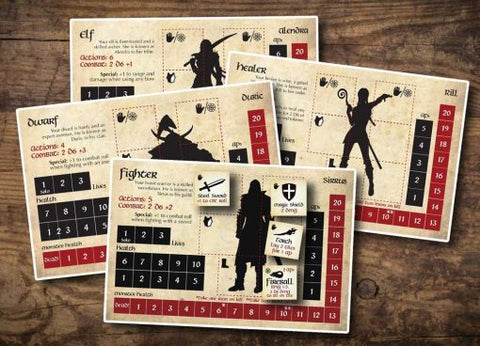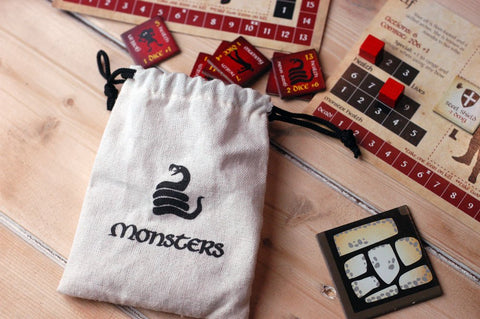Bag of Dungeon: Dungeon crawler board game made compact for family fun
Share

Unsheathe your sword, prepare your spell slots and take a deep breath; you are about to descend into the dungeon. Seeking the Ring of Creation, your small party of elves, dwarves, fighters and healers must battle classic monsters, collect precious loot and defeat the fearsome Red Dragon that guards the exit in Bag of Dungeon.
Published by the London-based indie company Gunpowder Studios and initially launched as a Kickstarter campaign (that was fully funded in 24 hours), Bag of Dungeon is a dungeon crawler board game for 1-4 players that uses a simple tile-laying system to allow players of 7+ years to explore a unique maze filled with monsters and treasures.
“I wanted Bag of Dungeon to be accessible and simple enough that it could sit on the family games shelf,” said designer Tim Sharville – who created the game along with Russ Law and Paul Sharville – in an interview with Mojo Nation.
“We also wanted it to be portable so that it would make it into the family holiday suitcase or be kept in a gamer’s rucksack. Hence, a dungeon in a bag.”
What’s in the box
How to set up the game
How to play
Playing the solo game
Playing the competitive or advanced game
What’s in the box?

For a small box, Bag of Dungeon certainly feels like a bag of holding for how much content is packed in: three bags (for the game, monsters and items), 40 dungeon tiles, 30 monsters, 40 items, four character cards (with male/female options), 16 wooden cubes, four wooden meeples, four 6-sided dice, Ring of Creation, 28 red/black tokens, Red Dragon token, rules booklet and 11 Dragon Scrolls.
The die cut pieces, from the dungeon tiles to the items/monsters squares and the Red Dragon token feel sturdy while all the elements, including the rules booklet, perfectly communicate the theme through mostly silhouette-esque illustrations in a black, white and red visual style – a familiar look to anyone on the board gaming scene in the 1980s.
Watch our quick unboxing video to see exactly what you’ll get.
Bag of Dungeon set up
Your adventure starts with the Start tile. Well, it actually starts with punching out the pieces from the punch boards but once you’ve done that, find the Start tile and put it in the centre of your play space.
Fish out the Exit tile and put it aside. Shuffle all the dungeon tiles then make two roughly even piles of tiles. In one pile, randomly shuffle in the Exit tile – this pile goes underneath the other one, creating one tall tower of dungeon tiles (face down).
Now choose your character. There are the hardy but slower moving dwarves Duric and Marria, the light-footed elves Alendra and Galhorn, the renowned sword fighters Sirrus and Tamara and finally, the gifted healers Rill and Tarak.

Along with your character, pick your meeple colour along with its four correspondingly coloured cubes. On your character card, place one cube on the highest health number, one cube on the ‘3’ on the lives track and one cube on the top Action Points number.
How to play Bag of Dungeon
To begin, all the meeples that are in-play get put on the Start tile.
Who is the bravest of them all? Because they get kicked down the dungeon stairs first.
To do anything in your adventure, you need Action Points (APs). Your character card shows how many APs you have per turn (use a cube to keep track).
Starting off, spend one AP to pick up and lay the first dungeon tile from the top of the tile stack. Like with Bandido, you need to connect the tiles together to form a path. New tiles are laid adjacent to the one your character (meeple) is standing on and if you can’t make a logical path, you put the tricky tile under the stack and end your turn.
Whether moving to the next tile, laying more of the dungeon path, using items or doing ranged combat, you’ll need APs. Once your APs have run out, you’re done with your turn and the next player can go. Your APs reset to full at the end of your turn and they can’t be carried over to the next one.
Your turn can also end before your APs run out if you enter a fight. When you lay a dungeon tile with an ‘M’ on it, monsters spawn there. Put a red/black token on the ‘M’ to indicate a monster. You can reveal what the monsters is by going onto that ‘M’ tile, which starts a fight.
In a fight, you randomly draw a monster (put all the monster squares in the monsters bag and give it a good shake). Get a paladin to pray for a goblin or zombie instead of a werewolf or giant snake.

On the monster ‘card’, you’ll see the type of monster, its health and how much damage it does. To fight it, roll your dice for an attack – refer to your character sheet for the number of dice you roll and any bonuses. Another player rolls for the monster and you keep track of its health via a cube on the red ‘monster health’ tracker on your character sheet. The lower scoring opponent takes damage equal to the score difference.
Keep rolling (rolling, rolling, c’mon) until you either get the monster down to 0 health or it does that to you. If you win, you can collect a random item or two depending on how much health the monster had. If you lose, all your precious loot is dropped on the tile where you’ve bravely ‘fallen’ while your meeple returns to the Start tile and your health goes down one on the Lives track.
Running from the fight is also valid, but you will take one damage as you flee, or two if you lay a new tile as you do so.
You may also phone a friend to help with the fight – one AP is spent on this but that doesn’t guarantee help. Why would someone refuse your desperate cries? Your potential helper needs enough APs to reach you and they cannot reset their APs after the fight. Also, nobody can escape during a tagged fight and your glamorous assistant will be taking half the damage you are, rounded down. If you do have nice players around you however, their help grants you an extra dice in the fight.
Don’t fancy getting up close and personal with a monster? If you have ranged weapons or spells, you can hit monsters that are within range (check the item descriptions) and are within direct line of sight from your meeple (no bending arrows around corners). If you haven’t killed the monster before your turn is over, the monster’s health resets to full.

While there may be more sticks than carrots, the dungeon also has item tiles where the first player to reach it can pick one random item. All items are kept on the character card provided there’s space for them. Some inventory spaces have specific symbols so only items with those corresponding symbols can be stored there.
Now, in all this excitement you may have forgotten your goal: to retrieve the Ring of Creation.
The precious Ring appears once the final dungeon tile has been placed. The last one to lay it down rolls two dice and puts the Ring on the M tile number of that combined dice total.
The exit is now sealed off now and can only be opened by the adventurer holding the Ring. Should they escape the dungeon, all other adventurers have one turn to leave before the dungeon collapses.
However, hic sunt dracones. The Red Dragon guards the exit. You must defeat her to leave the dungeon and this will be no easy feat with stats of 20 health and 4 dice of damage.
Fancy a solo RPG?
Feeling like you could tackle the dungeon by yourself? Solo gamers can play as up to 4 of the characters although each will only have one life.
Never fear being alone in combat for you can always give yourself a helping hand by tagging in another character although you must roll a dice to decide whether that help arrives (on a 1 or 2, they don’t).
As a solo game, Bag of Dungeon can certainly be fun. Playing with just two characters feels like a good balance between managing multiple movements while still having help in fights. The game plays faster this way as moving and laying tiles no longer depends on other players. However, minding more than two characters can get a little exhausting although it does guarantee a better chance of success. I lost against the Red Dragon the first time I played solo with two active characters but I did roll a natural 24 for the dragon so I am quite literally my own worst enemy.

Competitive gaming and Advanced Rules
Get ready for a little PvP.
In a competitive game, the surviving adventurer with the most monster kills is the winner. The Ring is worth four kills while slaying the dragon is worth two. You can also be killed by fellow adventurers who can pilfer your dropped items after death.
Still not challenging enough for you? Built into the base game are Advanced Rules. These change the game so you can no longer take pot shots at monsters from a distance as they’ll rush towards you after the first hit. We also welcome to the Start tile Fred the Gnome who can exchange dead monsters token or items for an item from his Lucky Dip. Read Fred’s T&Cs carefully as he offers no refunds on said Lucky Dip.
Finally, there are 11 Dragon Scrolls – stretch goal in the original Kickstarter campaign – which offer new quests, enemies and treasures. From saving a landed gentry tween to being beset by monster ambushes and defeating the Lava God, these scrolls can spice up your adventuring life.
For £34.99 (plus £3.50 for standard shipping) get a fun dungeon crawling game that’s easy to set up and play and even easier to take with you.
Can't get enough of Bag of Dungeon? Check out Bag of Dungeon Legends Expansion, Bag of Dungeon 2: The Cursed Forest and the Bag of Dungeon 2 Minifigures
You can also check out our full Gunpowder Studios range here.
